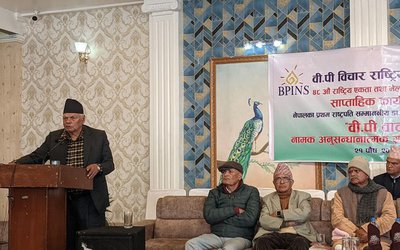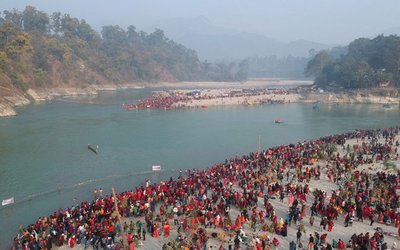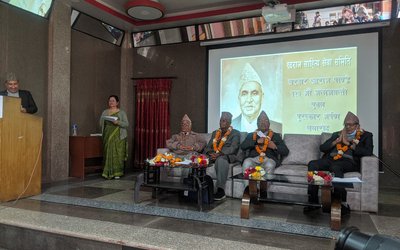
As one of the most vulnerable countries facing the impact of climate change, the challenge before Nepal is to launch climate change resilient programs at the community level.
With a number of priorities before it, Nepal lacks adequate internal resources for funding new activities. Naturally Nepal is looking for various funding options from different international sources.
Although Nepal’s current problem is the incapability of various institutions to spend monies, according to a recently released report of Ministry of Finance, Nepal spent just over 10 percent of its budget in capital expenditure.
Although Nepal has been receiving funds from different countries and from international funds, Nepal’s absorbing capacity is very low. Ministry of Finance recently revealed that Nepal is able to spend just over 10 percent of resources available from the international agencies.
Nepal needs to identify its priorities for the projects and Nepal needs to track the finance for the projects.
Nepal has enough documents which prioritize Nepal's needs. National Climate Change Policy, NAPA, strategy and other programs have made it clear where Nepal’s priorities are. From renewable energy to adaptation, Nepal has been launching various programs.
Although Nepal has already received over 200 million dollars equivalent in funds from different international funds, the money is just a small amount in terms of the programs Nepal needs to carry out.
“Nepal has accessed over 200 million dollar in budget now. As the budget is scattered, there is the need to bring it under one umbrella so that the government can track down how much money Nepal is receiving,” said Ram Prasad Lamsal, joint secretary of MoPE.
“The government is also making programs for the development of institutional capability so that Nepal can improve its expenditure and get more access to new funds,” said Lamsal.
Supported by Ministry of Population and Environment’s Nepal Climate Change Support Program, with technical Support from Prakriti Resource Center, Nepal has started discussions with various stakeholders on Climate Finance, Financing Resilience and Low Carbon Development in Nepal.
Chaired by Ram Prasad Lamsal, joint secretary at Ministry of Population and Environment, Naresh Sharma, undersecretary of ministry and chairman of Adaptation Fund Board opened the program, presenting the current status of climate funding and future needs of Nepal.
“We know the funding is available but how do we get the funding for our future programs which will be launched through the collaboration with the local bodies,” said Sharma. “Nepal does have resources now but it needs to get more budget in the coming days to implement the programs at the community level."
Climate finance is not a simple issue. “The issue of climate finance is complex. There is always debate in international climate financing over how to get the finance,” said Raju Pandit Chhetri, director Prakrit Resources Center. “Climate change has already impacted our society with extreme events occurring in our country. Poverty poses extreme challenges to adaptation. Finance is critical part to minimize the impacts.
Recently Nepal government has been acquiring funds from international organizations including LDC Fund, Adaptation Fund, Green Climate Fund, World Bank and Asian Development Bank. Besides, Nepal is also acquiring funds from bilateral development partners like DFID, USAID, DANIDA, FINIDA and European Union, UN agencies and INGOs.
“There are sources for funding. However, there is a complex process involved in acquiring the funds from these organizations. There are many intermediaries’ institutions and direct vs indirect,” said Raju Chhetri. “Climate finance refers to financing channeled by national, regional and international entities for climate change mitigation and adaptation projects and programs.”
The challenge is how these massive investments towards a low carbon and resilient economy, which we refer to as climate finance, can be realized. In developing countries, climate change investment needs are significant. Direct government funding is scarce.
Climate finance involves flow of funds from developed to developing nations to help poorer countries. The global climate finance architecture is complex and finance is channeled through multilateral funds such as global funds.
Given Nepal’s poor performance in overall spending, it will also have similar impacts in climate related projects. Based on community, NCCSP, however, has shown different results in implementing most of the programs targeted by it.
Climate finance involves flows of fund from developed to developing nations to help poorer countries to cut their emission and adapt to climate change. The sources and governance of climate finance has been widely debated since the 2009 climate change summit in Copenhagen where industrialized countries committed to giving 100 billion dollar in additional climate finance from 2020 onwards. To get things going immediate fast start finance of up to 30 billion was promised until the end of 2012.
“Given Nepal’s surplus internal resources, Nepal needs to mobilize the internal resources also,” said Ugan Manandhar, deputy director of WWF Nepal. “Let’s try for mobilization of local money.”
Along with adaptation, Nepal needs to work for mitigation also through use of renewable energy low carbon. "Common people have been showing interest to invest in hydropower, Nepal can build more hydropower which will contribute to low carbon development.”
Classification is always a problem particularly when it comes to dealing with the impact of climate change adaptation. Better education and healthcare, access to safe drinking water, improved disaster relief and the availability of micro-finance will make all countries more resilient to climate change. But they are also basic development objectives.
“UNDP has been supporting Nepal since early days. As implementing partner of GEF, UNDP has been helping Nepal to get funds for renewable energy programs and institutional capacity building,” said Vijaya Singh, assistant country director UNDP.
The climate finance landscape is dominated by bilateral aid agencies and international development institutions which implement GEF projects and have set up their own climate finance initiatives.
“Nepal needs to allocate more fund through local bodies so that the money can reach directly to the people,” said Ek Raj Sigdel, local environment specialist Ministry of Federal and Local Development.
Climate finance has been a central element of the international climate change agreements from outset. The UNFCCC agreement in 1992 stated that developed countries shall provide new and additional financial resources to developing countries.
- MELAMCHI WATER SUPPLY: No Interruption During Monsoon
- Jun 25, 2025
- KOREAN RETURNEES: Successful Integration
- Jun 25, 2025
- UPPER TRISHULI-1: Engaging With Local
- Jun 25, 2025
- IME GROUP: Twenty Five Years Of Journey
- Jun 24, 2025
- NEPAL’S AIR POLLUTION: A Growing Health Concern
- Jun 24, 2025















